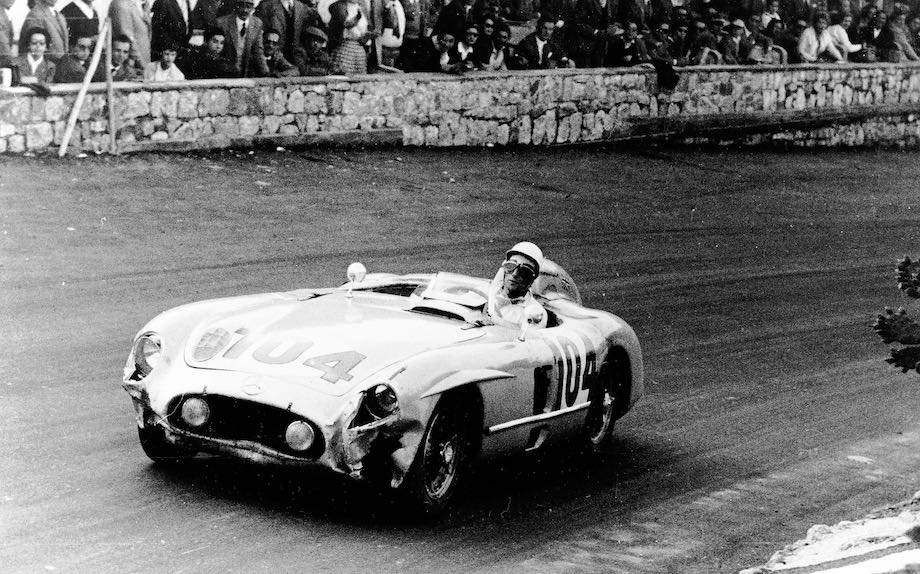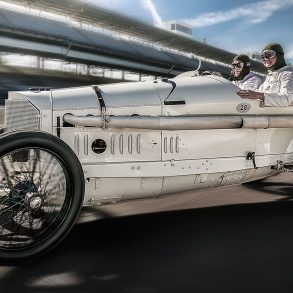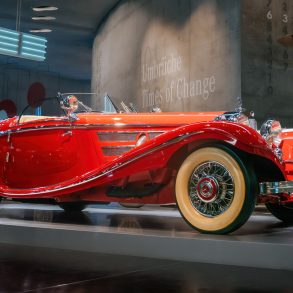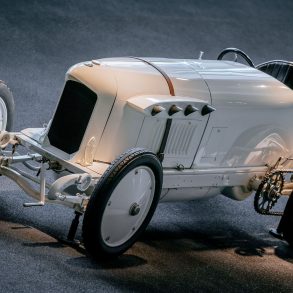The Targa Florio was the decisive contest in the 1955 World Sports Car Championship. Under tremendous pressure to succeed at the final race of the season, Mercedes-Benz finished first and second with the 300 SLR, just enough to win the World Championship.
1955 was a year of top-drawer motorsport: Juan Manuel Fangio won his second Formula One world title in a Mercedes-Benz W 196 R. Werner Engel was the European Touring Car Champion in his 300 SL Gullwing (W 198) production sports car and Paul O’Shea won the US Class D Sports Car Championship. The star of the World Sports Car Championship was the 300 SLR (W 196 S). Closely related to the Formula One racer, this was the car entered by Mercedes-Benz for the six-race series. The brand decided against contesting the first two races, the 1000 Kilometres of Buenos Aires on 22 January 1955 and the 12 Hours of Sebring on 13 March 1955, allowing the competition to open up a lead in the rankings, which Mercedes-Benz had to make up in the remaining four races.
The first appearance of the 300 SLR in Italy’s Mille Miglia on 1 May was to prove a spectacular debut, with Stirling Moss and Juan Manuel Fangio posting the brand’s first one-two finish in the World Sports Car Championship.

The next race was the 24 Hours of Le Mans on 11-12 June, at which Mercedes-Benz competed with three 300 SLRs. Yet, after the vehicle of Mercedes-Benz driver Pierre Levegh was involved in what was until then the worst accident in motorsport history, race manager Alfred Neubauer took the decision, in consultation with the company management, to withdraw the race-leading 300 SLRs out of respect for the victims. This meant that Le Mans brought no points for Mercedes-Benz. Its rivals having retaken the lead in the rankings, the brand from Stuttgart had just two races left in which to secure overall victory in the World Sports Car Championship — for that was the unambiguous intention with which Mercedes-Benz had gone into the six-race series.

At the International Tourist Trophy in Dundrod, Northern Ireland, on 17 September 1955, 300 SLRs took the first three places to propel Mercedes-Benz up the points table. But this was not enough, because Ferrari still had its nose in front. Worse still: a second-place finish in the last race of the season would be enough to give Ferrari the title, the team from Stuttgart needed not only a victory in the Targa Florio, but a one-two finish to keep out Ferrari and Jaguar.

Incidentally, there were two other 1955 races in which Mercedes-Benz entered its 300 SLRs, but these did not count towards the World Championship. Fangio and Moss finished 1st and 2nd in both the International Eifel Race on the Nurburgring on 29 May and the Grand Prix of Sweden in Kristianstad on 7 August.
Staged around the Circuito delle Madonie Piccolo in Sicily, the 1955 Targa Florio was destined to be the all-deciding race. As the cars lined up at the start for the 39th running of the classic Italian race at 7 a.m. on 16 October, the tension was palpable. The competition, especially Ferrari and Jaguar, would not give in without a fight.
The Mercedes-Benz crew was motivated to a man. The preparations for the “all or nothing” bid for victory in the Targa Florio attempted to take every eventuality into consideration. The race was contested by three 300 SLR teams. Under the race rules, there had to be a change of driver, with no driver at the wheel for more than five laps. The changeover cycles were coordinated to prevent two 300 SLRs being in the pits at the same time. The teams were made up of the pairings Stirling Moss and Peter Collins, Juan Manuel Fangio and Karl Kling and Desmond Titterington and John Cooper Fitch.
In preparation for the race, the drivers practiced for a total of 16,695 kilometres to ensure that they were familiar with the 72-kilometre circuit and its 900 curves. Owing to the length of the circuit, this was the first time Mercedes-Benz used radio communication to allow the main pits to keep the way station 29 kilometres away in touch with what was happening in the race. There, the drivers were informed about their position in the race by means of conventional sign boards.



Setting a blistering pace from the outset, Moss took over a minute off second-placed Eugenio Castellotti in his Ferrari and smashed the existing records — the overall average of 89.929 km/h set by the previous year’s winner, Piero Taruffi, as well as the lap record of 93.116 km/h posted by Castellotti in 1954 in a Lancia. On the third circuit, Moss came off the road, causing his team to drop back to third place. Yet, by the end of the ninth circuit, their Silver Arrow was back in front, thanks not least to a daring show of catch-up racing by Collins. With Kling and Fangio occupying second place, everything seemed to be going to plan.
However, after a jammed tank cap held them up in the pits during a driver change, the Ferrari team of Eugenio Castellotti and Robert Manzon were able to get ahead of Fangio into second place. There now began a breathtaking catch-up chase: driving at top speed, Fangio steadily reduced the gap between him and Castellotti. When, on the eleventh circuit, Manzon clipped a rock and was forced to change a wheel, the Argentinian was able to retake second place, which he successfully defended to the finishing line. Together with the race-winning team of Moss and Collins, this secured the World Sports Car Championship for Mercedes-Benz — just one point ahead of Ferrari.




With fourth place also going to the third 300 SLR of Titterington and Fitch, all the effort had been worthwhile. As the 1955 season had finished successfully for Mercedes-Benz, everyone expected to see the brand back at the start the next year. However, then came the announcement that Mercedes-Benz was pulling out of motorsport. It is often incorrectly rumored that the tragedy at Le Mans was the reason behind the decision. But the truth was that the company’s engineers and technicians needed to devote their full attention to developing production vehicles.
From early on in 1955 — months before Le Mans — there had been an internal debate at Mercedes-Benz over whether to carry on with the brand’s racing involvement. As reported in the motoring press at the time, Mercedes-Benz had given consideration in April 1955 to taking part once again in the World Sports Car Championship in the 1956 season, but to pulling out of Formula One. That would have seen the racetrack appearance of the coupe version of the 300 SLR, known as the “Uhlenhaut Coupe”, which did not contest a single race in 1955.
The background to the persistent, often heated debate inside the Board of Management was capacity problems in the company’s development department, which repeatedly affected the development and testing of planned new production vehicles, it proving impossible to meet the high demand for specialist staff. And so, on 11 October — just five days before the Targa Florio and, with it, Mercedes-Benz’s final victory of the 1955 season — the Board of Management decided to pull out of racing entirely and to devote the considerable engineering expertise of its motorsport department to the development of production vehicles. However, the decision was not made public until after the Targa Florio.
[Source: Daimler AG]











Thank you for the outstanding work you always do.
I agree with Mark Dill – you make my Thursdays come alive!